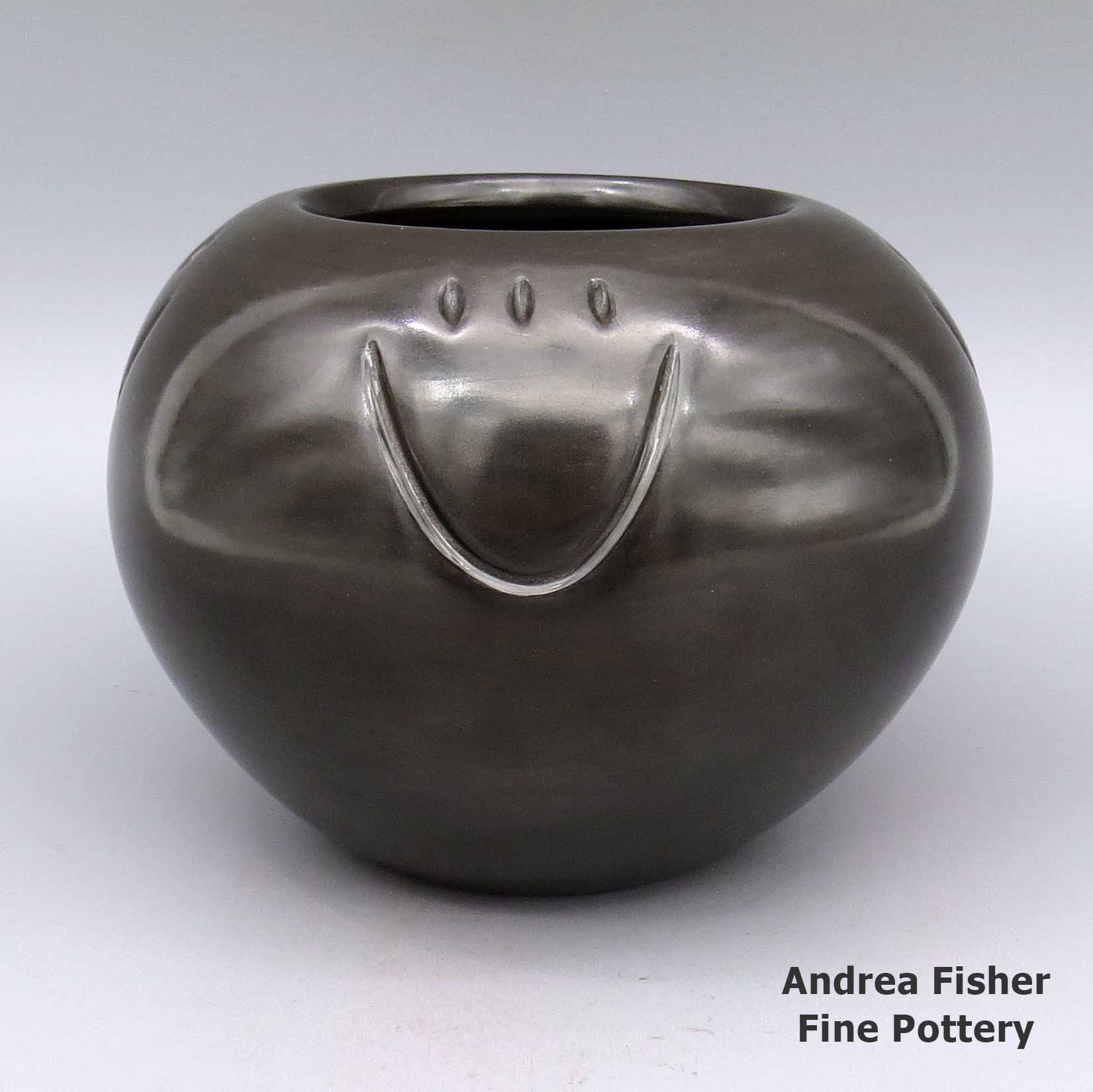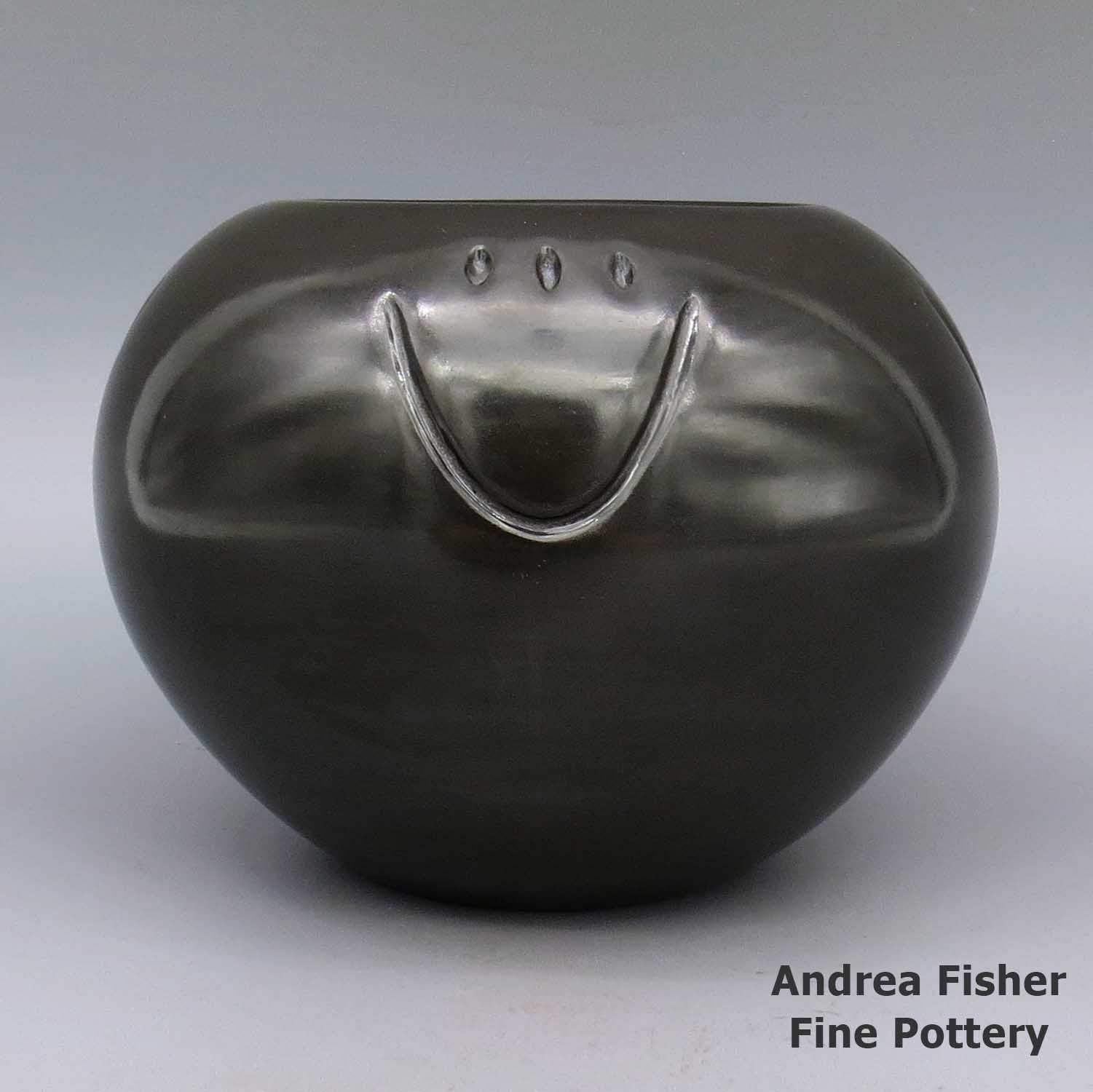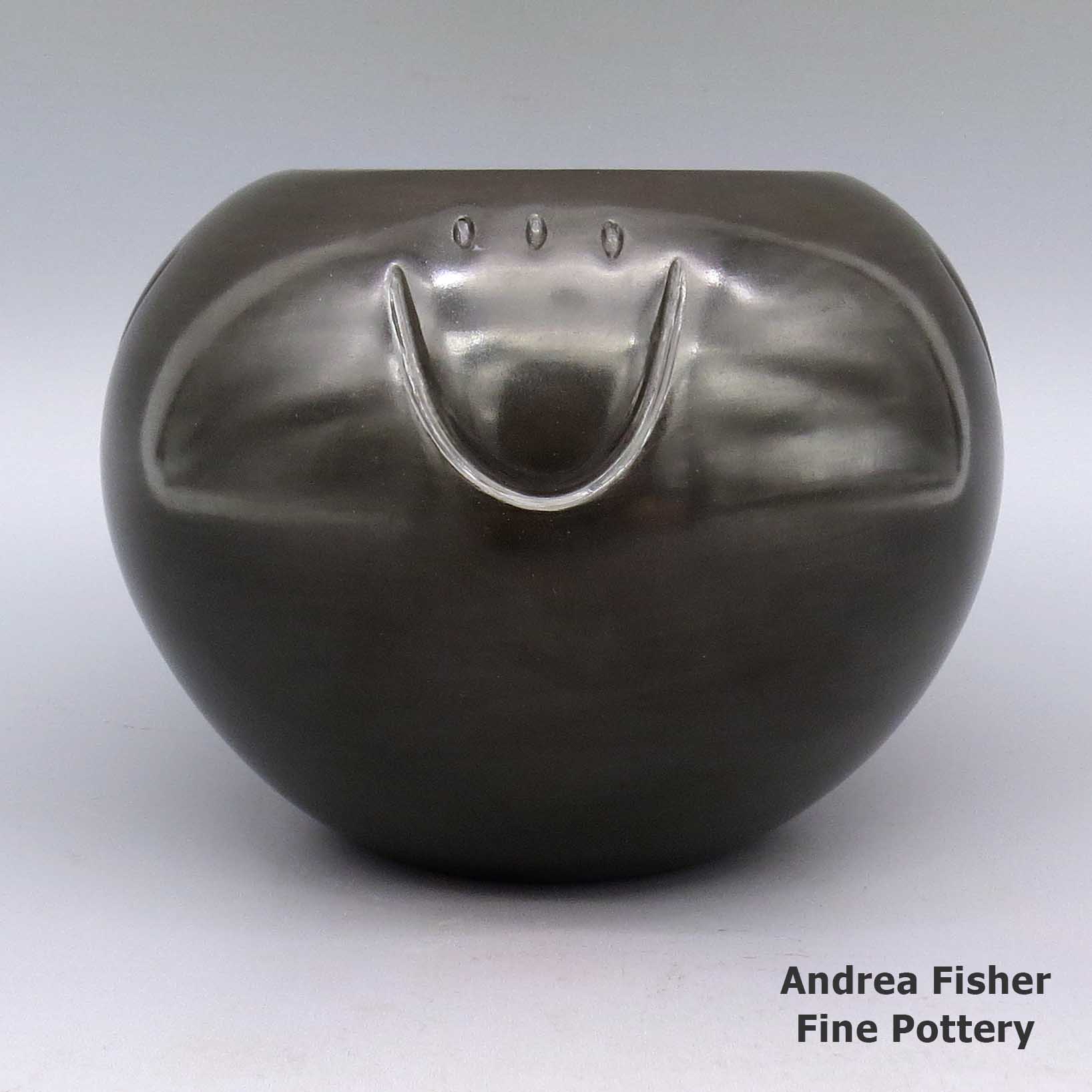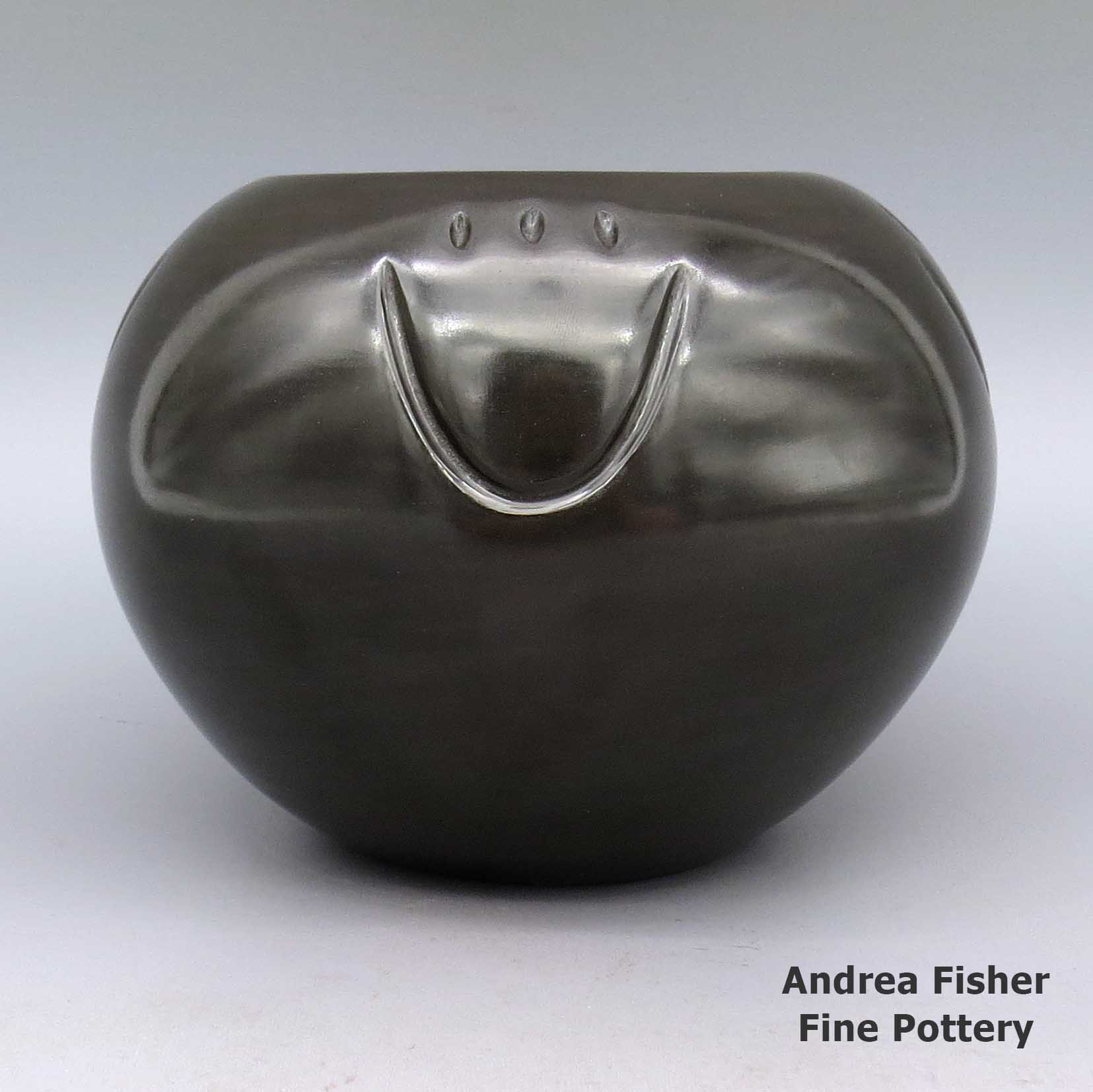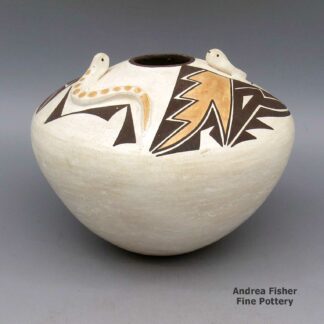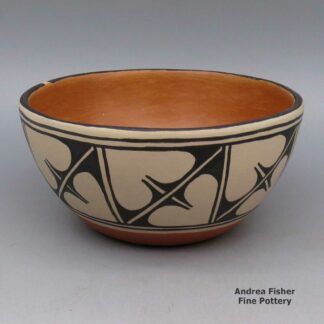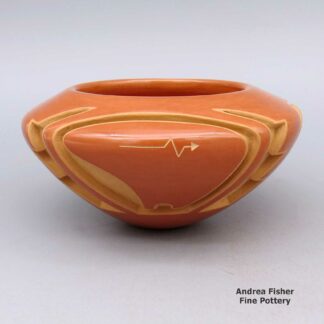| Dimensions | 6.5 × 6.5 × 5 in |
|---|---|
| Signature | Toni Roller Santa Clara Pueblo |
| Date Born | 2003 |
Toni Roller, mcsc2h160, Black bowl with carved bear paw design
$2,200.00
A black bowl carved with a bear paw design
In stock
Brand
Roller, Toni
Toni used to speak of making her first pot at the age of six but back in those days, she said she was also more interested in making clay marbles and firing them in the same fires where her mother was firing pottery to sell (imagine the results if any of her marbles had exploded).
Toni was focused on her art in her early years and sold her first piece in 1968. Right after that came the years when she was too busy raising seven children. In the early 1990s she returned to making pottery full time and quickly became known for her fantastic polish and crisp carving.
Toni earned many ribbons over the years, beginning with the Eight Northern Pueblos Arts & Crafts Show in 1973 and continuing for more than 30 years. Her work is on display in museums and galleries around the world, from the Heard Museum to the White House Collection to the Vatican Collection.
Toni still makes pottery, still digs and processes her own clay, forms and polishes her pots, carves the designs and then fires them outdoors, just as she was taught by her mother so many years ago. She's just not as spry about it.
A Short History of Santa Clara Pueblo

Santa Clara Pueblo straddles the Rio Grande about 25 miles north of Santa Fe. Of all the pueblos, Santa Clara has the largest number of potters.
The ancestral roots of the Santa Clara people have been traced to ancient pueblos in the Mesa Verde region in southwestern Colorado. When the weather in that area began to get dry between about 1100 and 1300 CE, some of the people migrated to the Chama River Valley and constructed Poshuouinge (about 3 miles south of what is now Abiquiu on the edge of the mesa above the Chama River). Eventually reaching two and three stories high with up to 700 rooms on the ground floor, Poshuouinge was inhabited from about 1375 CE to about 1475 CE.
Drought then again forced the people to move. One group of the people went to the area of Puyé (along Santa Clara Canyon, cut into the eastern slopes of the Pajarito Plateau of the Jemez Mountains). Another group went south of there to what we now call Tsankawi. A third group went a bit to the north, following the Rio Chama down to where it met the Rio Grande and founded Ohkay Owingeh on the northwest side of that confluence.
Beginning around 1580, another drought forced the residents of the Puyé area to relocate closer to the Rio Grande. There, near the point where Santa Clara Creek merged into the Rio Grande, they founded what we now know as Santa Clara Pueblo. Ohkay Owingeh was to the north on the other side of the Rio Chama. That same dry spell forced the people down the hill from Tsankawi to the Rio Grande where they founded San Ildefonso Pueblo to the south of Santa Clara, on the other side of Black Mesa.
In 1598 Spanish colonists from nearby Yunqué (the seat of Spanish government near the renamed "San Juan de los Caballeros" Pueblo) brought the first missionaries to Santa Clara. That led to the first mission church being built around 1622. However, the Santa Clarans chafed under the weight of Spanish rule like the other pueblos did and were in the forefront of the Pueblo Revolt of 1680. One pueblo resident, a mixed black and Tewa man named Domingo Naranjo, was one of the rebellion's ringleaders.
When Don Diego de Vargas came back to the area in 1694, he found most of the Santa Clarans were set up on top of nearby Black Mesa (with the people of San Ildefonso, Pojoaque, Tesuque and Nambé). An extended siege didn't subdue them but eventually, the two sides negotiated a treaty and the people returned to their pueblos. However, successive invasions and occupations by northern Europeans took their toll on the pueblos over the next 250 years. The Spanish flu pandemic in 1918 almost wiped them out.
Today, Santa Clara Pueblo is home to as many as 2,600 people and they comprise probably the largest per capita number of artists of any North American tribe (estimates of the number of potters run as high as 1-in-4 residents).
For more info:Pueblos of the Rio Grande, Daniel Gibson, ISBN-13:978-1-887896-26-9, Rio Nuevo Publishers, 2001
Upper photo courtesy of Einar Kvaran, Creative Commons Attribution-Share Alike 3.0 Unported License
About Bowls
The bowl is a basic utilitarian shape, a round container more wide than deep with a rim that is easy to pour or sip from without spilling the contents. A jar, on the other hand, tends to be more tall and less wide with a smaller opening. That makes the jar better for cooking or storage than for eating from. Among the Ancestral Puebloans both shapes were among their most common forms of pottery.
Most folks ate their meals as a broth with beans, squash, corn, whatever else might be in season and whatever meat was available. The whole village (or maybe just the family) might cook in common in a large ceramic jar, then serve the people in their individual bowls.
Bowls were such a central part of life back then that the people of the Classic Mimbres society even buried their dead with their individual bowls placed over their faces, with a "kill hole" in the bottom to let the spirit escape. Those bowls were almost always decorated on the interior (mostly black-on-white, color came into use a couple generations before the collapse of their society and abandonment of the area). They were seldom decorated on the exterior.
It has been conjectured that when the great migrations of the 11th, 12th, 13th and 14th centuries were happening, old societal structures had to change and communal feasting grew as a means to meet, greet, mingle with and merge newly arrived immigrants into an already established village. That process called for larger cooking vessels, larger serving vessels and larger eating bowls. It also brought about a convergence of techniques, styles, decorations and design palettes as the people in each locality adapted. Or didn't: the people in the Gallina Highlands were notorious for their refusal to adapt and modernize for several hundred years. They even enforced a No Man's Land between their territory and that of the Great Houses of Chaco Canyon, killing any and all foreign intruders. Eventually, they seem to have merged with the Towa as those people migrated from the Four Corners area to the southern Jemez Mountains.
Traditional bowls lost that societal importance when mass-produced cookware and dishware appeared. But, like most other Native American pottery in the last 150 years, market forces caused them to morph into artwork.
Bowls also have other uses. The Zias and the Santo Domingos are known for their large dough bowls, serving bowls, hair-washing bowls and smaller chili bowls. Historically, these utilitarian bowls have been decorated on their exteriors. More recently, they've been getting decorated on the interior, too.
The bowl has also morphed into other forms, like Marilyn Ray's Friendship Bowls with children, puppies, birds, lizards and turtles playing on and in them. Or Betty Manygoats' bowls encrusted with appliqués of horned toads or Reynaldo Quezada's large, glossy black corrugated bowls with custom ceramic black stands.
When it comes to low-shouldered but wide circumference ceramic pieces (such as many Sikyátki-Revival and Hawikuh-Revival pieces are), are those jars or bowls? Conjecture is that the shape allows two hands to hold the piece securely by the solid body while tipping it up to sip or eat from the narrower opening. That narrower opening, though, is what makes it a jar. The decorations on it indicate that it is more likely a serving vessel than a cooking vessel.
This is where our hindsight gets fuzzy. In the days of Sikyátki, those potters used lignite coal to fire their pieces. That coal made a hotter fire than wood or manure (which wasn't available until the Spanish brought it). That hotter fire required different formulations of temper-to-clay and mineral paints. Those pieces were perhaps more solid and liquid resistant than most modern Hopi pottery is: many Sikyátki pieces survived intact after being slowly buried in the sand and exposed to the desert elements for hundreds of years. Many others were broken but were relatively easy to reassemble as their constituent pieces were found all in one spot and they survived the elements. Today's pottery, made the traditional way, wouldn't survive like that. But that ancient pottery might have been solid enough to be used for cooking purposes, back in the day.
About Bears and Bear Paws
At Santa Clara there's a story about a time when the people were suffering through a very severe drought. There was no rain for so long the rivers and ponds were drying up. They didn't know what to do. Then early one morning, a young boy stepped outside and saw a bear moving through the village. A bear meant there was enough water somewhere to support the bear and its food. So he followed the bear and the bear led him into the forested hills to a formerly unknown spring that was still flowing. Shortly after they found that spring, the weather changed and the rains came back.
The village celebrated their survival and have since elevated the bear to the standing of a special sacred animal charged with looking out for their welfare. The symbol of the bear and the bear paw carry on that tradition of doing homage to a character in their spiritual world.
That particular elevation is specific to the Pueblo of Santa Clara. Among all the pueblos, the Bear clan is the medicine clan. That makes them the most powerful clan in most villages. Some pueblos have traded members in the past in order to strengthen one or another of the primary clans at another pueblo. Often it is members of the Bear clan.
Margaret Tafoya Family Tree - Santa Clara Pueblo
Disclaimer: This "family tree" is a best effort on our part to determine who the potters are in this family and arrange them in a generational order. The general information available is questionable so we have tried to show each of these diagrams to living members of each family to get their input and approval, too. This diagram is subject to change should we get better info.
- Margaret Tafoya (1904-2001) & Alcario Tafoya (d. 1995)
- Mary Ester Archuleta (1942-2010)
- Barry Archuleta
- Bryon Archuleta
- Sheila Archuleta
- Jennie Trammel (1929-2010)
- Karen Trammel Beloris
- Virginia Ebelacker (1925-2001)
- James Ebelacker (1959-) & Cynthia Ebelacker
- Jamelyn Ebelacker
- Sarena Ebelacker
- Richard Ebelacker (1946-2010) & Yvonne Ortiz
- Jason Ebelacker
- Jerome Ebelacker & Dyan Esquibel
- Andrew Ebelacker
- Nicholas Ebelacker
- James Ebelacker (1959-) & Cynthia Ebelacker
- Lee Tafoya (1926-1996) & Betty Tafoya (Anglo) (1933-1988)
- Linda Tafoya (Oyenque)(Sanchez)(1962- )
- Antonio Jose Oyenque
- Jeremy Rio Oyenque
- Maria Theresa Oyenque
- Melvin Ray Tafoya (1957- )
- Phyllis Bustos Tafoya
- Linda Tafoya (Oyenque)(Sanchez)(1962- )
- Mela Youngblood (1931-1990) & Walt Youngblood
- Nancy Youngblood (1955- )
- Nathan Youngblood (1954- )
- Toni Roller (1935-) & Ted Roller
- Brandon Roller
- Cliff Roller (1961- )
- Deborah Morning Star Roller
- Jeff Roller (1963- )
- Jordan Roller (1987- )
- Ryan Roller
- Susan Roller Whittington (1955- )
- Charles Lewis (1972- )
- Tim Roller (1959- )
- William Roller
- LuAnn Tafoya (1938- ) & Sostence Tapia
- Michele Tapia Browning (1960- )
- Ashley Browning
- Mindy Browning
- Daryl Duane Whitegeese (1964- ) & Rosemary Hardy
- Samantha Whitegeese
- Tina Whitegeese
- Michele Tapia Browning (1960- )
- Shirley Cactus Blossom Tafoya (1947-)
